Subtitle – what I wish I knew before planning my Fall photo excursion to Mabry Mill, Mile Post 176, Blue Ridge Parkway, Virginia.
I’m certain I stand with countless photographers who have seen beautiful images of Mabry Mill totally framed in a blaze of fall foliage color and put the ‘Mill in Fall’ on the bucket list. Mabry Mill has been on my bucket list for years and finally I made photographing the mill a top priority.
Planning for a photo shoot away from home takes advance preparation. My favorite tool for pinpointing peak color is the advanced image search in Flickr. I entered “Mabry Mill” as my search term, and then in advanced search I selected a date range of September 1 to November 1, 2014 as my filter. Assuming the artist has not changed the metadata, Flickr will show the date taken for any image selected. I also knew that a friend of mine visited the Mill last year on October 16 and the leaves had already dropped. Based on my research and a desire to arrive mid-week rather than on the weekend I picked a date of October 13 for sunset, and October 14 for sunrise with an overnight stay in Meadows of Dan.
I also mapped a route that followed interstates at first but then joined the Blue Ridge Parkway for some pleasurable driving. There are not many entry points for the parkway, and I had to study my googlemap to find an entry and get a street address near that point that I could use to enter into my GPS. Likewise I decided to return home a scenic route along the south side of Virginia and I needed addresses for the GPS to keep myself on that path rather than return to an interstate.
As the date approached I feared I was too early – the trees around Richmond Virginia had barely begun to show color, and it was very spotty. I checked Flickr and discovered a few photos of the Mill taken on Oct 10 with the tree adjacent to the mill in full color, but no color behind the mill. So I stuck to my plan and left early on Tuesday morning for the 4+ hour drive with my dog riding shotgun. Again, my fear of being too early surfaced as very little color appeared in the foliage along the parkway.
My heart sank when I got to the Mill – the fall foliage color I had seen in photographs taken only 3 days prior was gone! The photo opportunity I had envisioned for so many years dissolved before my eyes. I spoke to another photographer at the site who said that just the day before it rained with wind that took down the leaves. Missed it by one day!?!? Word to the wiser me: watch the weather for rain just prior to a planned excursion.
I had checked sunset and sunrise times for Roanoke prior to leaving home and knew that I had about 2 and a half hours before sunset. For shooting structures where the sky is not likely to produce the brilliant colors in predawn and dusk light – generally my favorite times to photograph – photographers aim to photograph in the “golden hours” of about 1 hour after sunrise and 1 hour prior to sunset. Light is considered “soft” because it is more diffused by the angle of the sun, losing fewer details to extreme shadows or blown-out highlights which can occur in mid-day light. Also during this time sun light travels through more of the earth’s atmosphere, creating light which is warm or “golden” as the earth’s atmosphere scatters more of the blue wavelengths leaving red, orange and yellow light to reach the earth’s surface, and it adds dimension to the subject because it is coming from the side rather than straight down.
But the Mill is in a depression surrounded by trees and the only sunlight during those golden hours is dappled light, something we photographers tend to avoid because of the harsh contrasts it can create! Add this to the list of things I didn’t know when I started out!
Just to be sure, I walked completely around the mill looking for an angle that may incorporate a colorful sunset but the iconic photo of the mill, which is known as “the most photographed location on the Blue Ridge Parkway”, is the photo with the pond in the foreground. After surveying the landscape I set up my camera and started to shoot – the first image is at the top of this post.
To capture the water flowing from the waterwheel required patience. Much of the water from the stream feeding into the flume is drained off prior to reaching the mill. This means only a slow trickle falls into the waterwheel which remains stationary during this time, until it seems all the buckets in the wheel are completely full and the water weight starts to turn the wheel. This results in a second or two of water flow then the wheel coasts to a stop. It takes 10-15 minutes for the wheel to fill, with lots of dripping and leaking from the aging wheel, and during this time it is easy to get distracted and miss the water dump. I set my camera to high continuous shooting and attached my remote trigger. While I usually caught one frame just about at the right time, I remained in place for another water cycle just to be sure. And I am glad that I did – in some frames the water dump occurred at the same time as a car would pass by on the parkway.
In addition to tracking the time of sunset and sunrise it is important to know the direction of the light at those times. Anyone who has noticed that the rising sun enters an eastern facing window from the left may notice as the year progresses that sun is now coming into the window from the right has observed the seasonal change in the sun’s position. The inclination of the earth’s rotation axis causes the seasons and the position of sunrise and sunset to change every day. This will affect the plane at which the sun strikes a structure. In the case of Mabry Mill, the sun at sunset around mid-October is clearly on the narrow side of the building closest to the road, casting the moving waterwheel into shadow.
I continued to photograph the mill, looking for colorful foliage to frame the scene, for a clear reflection in the pond, and for the ducks to wander into the scene, until the sun fully set. I was careful to avoid the sky in the photos – the sky was a uniform shade of light blue with no clouds, which added nothing to the scene. I can attest to the fact that as the golden hour approached and passed the amount of light on the narrow side simply diminished as tree limbs blocked the light. From this observation I would recommend several scenarios – 1) arriving earlier than the traditional “golden hour” to get some light on the structure, 2) wait until the sun has set to even out the light, or 3) shoot on overcast days with soft diffused light to eliminate harsh shadows which will also serve to saturate the color in the fall foliage.
My plan was to also photograph at sunrise and I stuck to my plan even after knowing what I now knew about the location. I was the only person at the Mill in the wee hours before sunrise, and it remained that way until well after the sun had risen. This is contrary to what I had read, that people arrived for sunrise only to find dozens of photographers already on site. Perhaps they knew the fall foliage color show was over, or the crowds appear on weekends not on Wednesday morning.
I was able to get a few photos prior to the sun rising, and to my delight three deer appeared from behind the mill on the left just as I was shooting. I saw a lovely pink light appear on the underbelly of a cloud but there was no composition that could include the mill and the cloud. When the sun light finally reached the building it was again dappled light, but it was both soft and subtle and struck the side of the building with the waterwheel. Again the sky was a clear blue and created so many bright spots in the tree foliage that I concentrated on framing without the sky. But my continued disappointment in finding the color that I had envisioned for my photos prior to my trip haunted me.
I photographed until the Mill officially opened and school buses arrived with children to watch demonstrations inside the mill and the blacksmith’s shop and the Appalachian house and so many other educational exhibits.
Once home I began the process of selecting images to illustrate this blog. But first I spent quite a bit of time studying the photographs of folks more lucky than I was in shooting the fall foliage. Photo after photo seemed to have a large tree with bright orange foliage directly behind the mill. This tree filled the sky making it possible to include more of the landscape above the structure, and even to include some sky. But my photos had only an evergreen tree in that location. I started looking at photos taken from different angles that included this tree and compared to my photos. I eliminated the tree at the road’s edge which I did have and which had dropped its leaves in my photo, but there was still one more tree, closely aligned with the back of the mill.


NOT MY PHOTO – for illustration only.
I can only surmise that at some point this tree was removed, perhaps during the restoration of the Mill in summer of 2014, although I could not find confirmation online. If anyone has information that can confirm or decline my thoughts please let me know!
I hope my learning experience can help you to plan the best time to photograph Mabry Mill and add a few insights into considerations for shooting. Here is a brief summary:
1. Visit in spring when the rhododendron is in bloom (again, something that must be carefully timed). It may no longer be possible to get a fall foliage photo with color behind the mill.
2. Check Flickr for timing your visit for fall foliage peak and keep track of the weather between the time you see color in the trees and your planned journey.
3. Photograph any time of the day in soft overcast light.
4. Look for foggy mornings or for days with skies with some cloud interest. If no clouds in the sky near the horizon, frame your photo to avoid having the sky in the photo.
5. Time your shots to capture the brief times that the water turns the waterwheel and flows into the pond. Best to shoot in continuous mode with a remote shutter release.
6. The golden hour starts earlier than expected for sunset if you want to catch the light on the narrow side before shaded by the trees (arrive about 2.5 hours before sunset), and later than expected for sunrise because it takes time for the sun to reach the structure through the trees.
7. Look for the mature tree behind the mill and let me know if it’s still there!
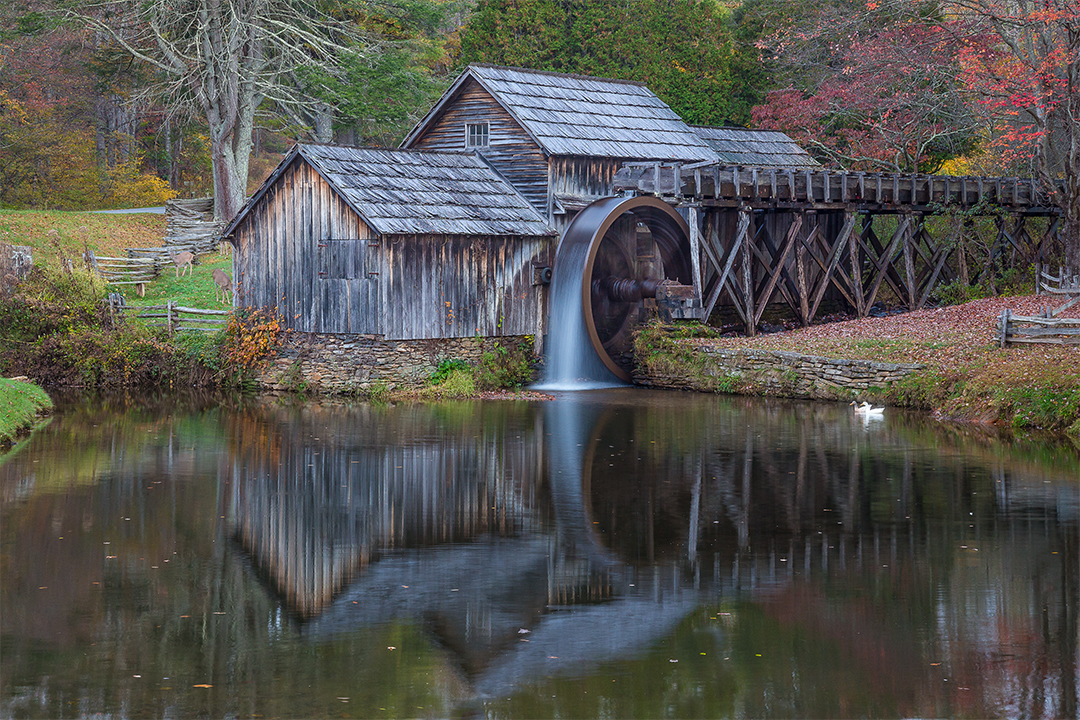
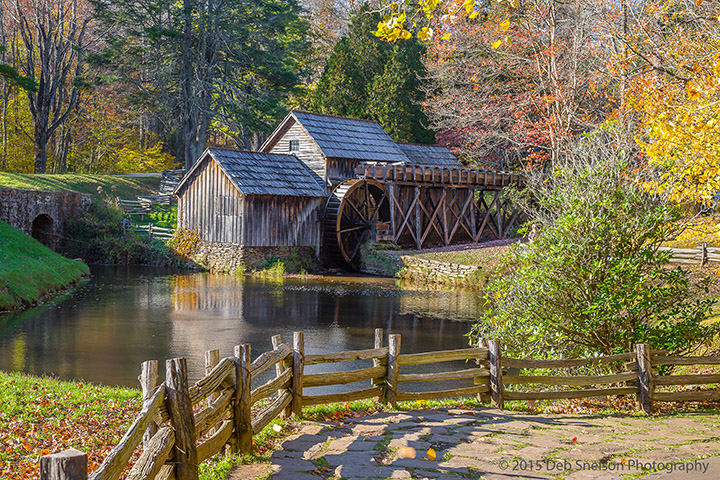
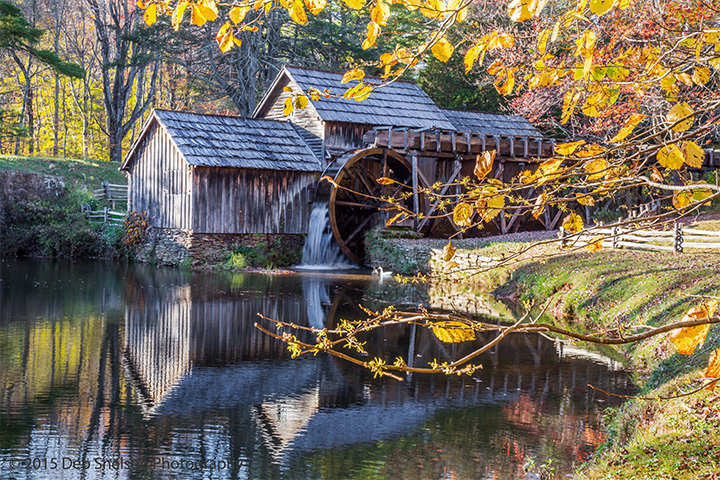
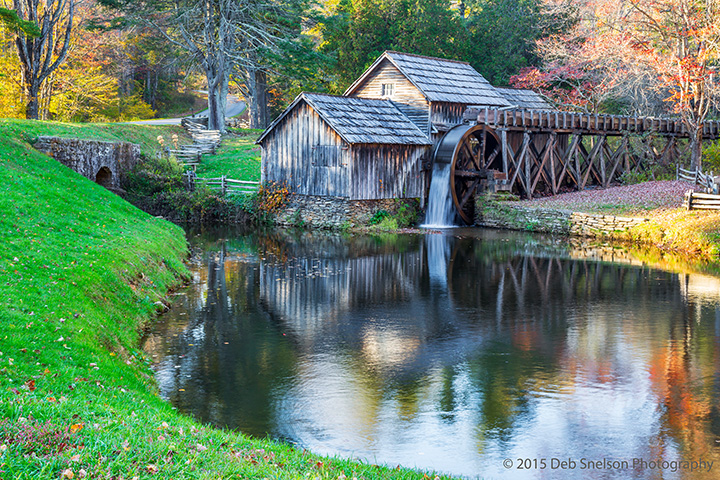

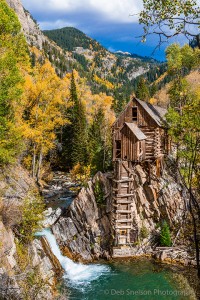

William Cody Carlyle
28 Sep 2020THANK YOU THANK YOU THANK YOU!
Heading that way in 2 weeks and I found this an incredibly helpful resource. I really appreciate people like you who take their time and effort to do things like this for other people.
Deb Snelson
28 Sep 2020Thank you William for that! Hope your photo shoot goes well!
Allen Withers
16 Oct 2015Deb, thanks so much for this great post with lots of useful information. I enjoy reading your photography blog!!
Deb Snelson
16 Oct 2015Thank you Allen. I rushed to get this post up to be useful for this year’s “hunt” for fall foliage photo ops. I think we can scratch off Mabry Mill for the fall…. very sad.